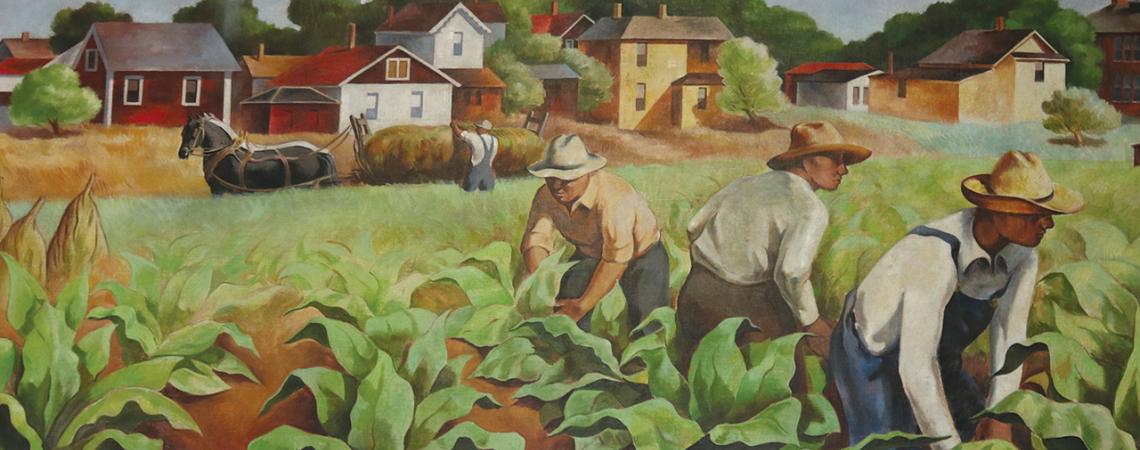Richard Zoellner’s Tobacco Harvest adorns the wall at the post office in Georgetown.
During the Great Depression, two federal programs — the Public Works of Art Project (PWAP) and the Federal Art Project (FAP), which was a part of the Works Progress Administration (WPA) — put thousands of artists to work. Murals were painted across the U.S., including more than 60 in Ohio, with post offices reaping the bounty.
The post offices, several of which themselves were built with WPA money, “are a great snapshot of Ohio history and public art,” says Barbara Powers, head of the State Historic Preservation Office. “So many murals focused on scenes with local connections and an element of nostalgia.” Many of the buildings still retain their original woodwork and features.
The murals, mostly oil on canvas and glued to the walls, are as varied as the communities that inspired them.
When artist Albert Kotin took on the Ada post office mural in 1939, he imagined life in the 1800s when “people had settled down to peaceful pursuits,” he wrote. His Country Dance is a lively mix of musicians, partner-swinging couples, and children joining in.
In Marysville, James Egleson’s nostalgic view depicts two farmers, hoes propped nearby, reading their newspapers as their cows look on. In 1940, Egleson painted The Farmer fresco-style, directly on a post office wall.
Ron Best’s 1942 mural in the Waverly post office also tells of nostalgic times. Arrival of the Packet shows a boat with passengers traveling along a canal while townspeople look on.
Artist Wendell Jones turned to Granville’s religious past for inspiration. In the 1938 First Pulpit in Granville, settlers join in thanks after cutting down a tree for their first altar and pulpit. For Jones, his painting shows Americans as those who “shall never be destroyed.”
At age 13, Herman Wessel went to the Cincinnati Art Academy, beginning a career that spanned the world. His two 7-foot murals in the Springfield post office depict the city’s early industries. Printing in Springfield and Manufacture of Farm Implements are in the post office’s original section, which is now a museum. The detailed, art deco postal windows and the period artifacts round out the artistic touches in the room.
Like the Springfield post office, other post offices have changed. The original post office in Fairborn has been turned into a library. Fortunately, the 1941 Wright Brothers in Ohio mural by Henry Simon was moved to the town’s new post office.
In 1940, when Lloyd R. Ney painted his New London Facets in the New London post office, town resident Vaughn Neel was 11 years old. Later, as the post office’s window clerk, Neel created a binder of mural-related correspondence and articles. “This is one of three murals like it in the U.S.,” recalls Neel, who at 88, recently retired as treasurer of the New London Historical Society. Ney pushed for his abstract design to be accepted by the FAP, which leaned toward realistic scenes. Recently cleaned, the mural showcases the bright colors of Ney’s vision, and the post office still has the binder that Neel created.
Ohio native Richard Zoellner has murals in two post offices. Tobacco Harvest, painted in 1938 for the Georgetown post office, shows farmers in a tobacco field with Georgetown’s prominent buildings in the background. His smaller 1937 murals in the Portsmouth post office, Coal Barges and Waterfront, depict that town’s river history.
Also at the Portsmouth post office, town native and artist Clarence H. Carter’s four murals, Characteristic Local Scenes in Portsmouth, cover three walls. Although Carter’s visual story of Portsmouth’s riverboat, farming, and factory history is stunning, for longtime resident Robert Mohl, the mural of the town’s 1937 flood is most remarkable. “See how the sacks were filled to try to stop the water,” he says, pointing to the frantic scene.
For Mohl, 80, the murals opened his mind when he was a child. “When you are a kid, you are down so low — the murals are up so high. It’s staggering to realize that the world isn’t billboards once you appreciate the world of handmade, of brushes, colors, and ideas.”
Jamie Rhein is a freelance writer from Columbus.









